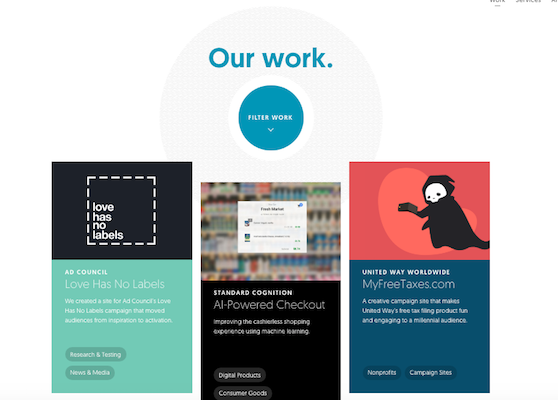Large agencies are still king of the hill in advertising — but in recent years, boutique agencies have started capturing business from big agencies. Businesses perceive smaller agencies as better able to take on their company’s vision and story — at a fraction of the price.
Kevin Hayes, Director of Digital & Media Strategy at The Phoenix Group puts it this way:
These new agencies were born because the mammoth marketing agencies acted like, well, mammoths — woolly mammoths, to be more precise: big, awkward and unable to adapt. They didn’t understand digital and, in my experience, were afraid to correlate campaign results with their work.
Many companies including Pops, KitchenAid, and Discovery Channel have perceived this slow reaction to marketplace change and have put their advertising efforts into the hands of smaller agencies.
Even with boutique agencies gaining traction, big agencies still have the experience and resources to deliver powerful campaigns. But, to keep winning pitches, they must respond to clients’ needs in changing environments.
Here are six ways big agencies can frame their strengths to deter clients from working with the underdogs.
6 ways big agencies can win clients
1. Big agencies focus on value, not price
Big agencies tend to be significantly more expensive than boutique agencies — but that’s for a reason.
Take WPP plc, for example. The firm is one of the largest advertising and PR agencies in the world and just announced a special relationship with Waze. Only WPP clients can take advantage of new advertising technology in the Waze app:

These advertisements are non-distracting ads that correspond with the driver’s experience — like passing specific restaurants or gas stations. Millions of people use Waze daily and will now be exposed to only WPP plc client adds. WPP plc offers features, resources, and connections that boutique agencies simply can’t compete with.
Jason Swenk, agency consultant, says that agencies need to focus on the value they offer clients. When companies object to your services, saying that your fees are too expensive or out of their budget, you need to ask them questions about their needs and goals. Show potential clients what specific steps your agency will take to help them to meet their goals and boost their bottom line.
The key is that you can’t just tell prospects about the value you offer. You have to prove it, which leads to point two.
2. Big agencies have powerful case studies
Powerful case studies are where big agencies can show off their talent and why they are worth the extra investment. Boutique agencies might not have the experience, data, or resources to put together highly intelligent, beautiful, and compelling case studies. But big agencies do, like Viget highlights here:

Potential clients will not trust salespeople based on a powerful pitch. Though a solid elevator pitch is the first step to gaining interest from a lead, it’s not enough to win a company’s trust. Companies need to see your best work to determine if your agency is a fit for them.
It is not enough just to showcase the biggest brands or even your most successful campaigns. Highlight case studies that your potential clients will relate to most. After learning about their size, industry, style, and goals, you can tastefully select the case studies that are closest to their profile. Demonstrate how you partner with similar companies and what actions your team performed to gather definable results.
Your team can take it to the next level by proactively offering references. Let your leads know that you recognize that choosing an agency is a big decision. Prospects don’t have to only take you at your word, but they can call references to learn more.
3. Big agencies offer full-service packages
Today, there are more marketing channels than ever, more tools for data analysis, and more details to keep tabs on. Big agencies likely have the resources, advanced technology, and manpower to manage everything to run full-service marketing campaigns.
Boutique agencies might be able to offer more nimble and specialized aspects of digital marketing, but they usually can’t offer all the services a company might need, especially at scale.
Big agencies have a bad rap for not being as efficient as small agencies. They are “complex, with layers of account people to ‘service the relationship,’ which takes the focus away from creativity. There’s too much time spent on conference calls, meetings, off-sites, travel and useless PowerPoint presentations,” writes Avi Dan, agency search consultant.
“Agency teams in hundreds of offices engage in essentially the same activity, resulting in significant waste and unnecessary cost to the clients.”
But at the same time, any marketing campaign is a large puzzle with many integrated pieces — communication, design, writing, editing, task organization, and A/B testing.
“That’s the nature of an industry evolving faster in its media than in its makeup,” says Chris Sojka, CCO and Co-founder of Madwell. Small agencies face challenges in efficiency just like their larger competitors.
Companies cannot get around the multifaceted nature of marketing today. But they do have to decide who bears the responsibility of bringing all the (inherently inefficient) components together — an experienced agency or themselves.
If your client signs with a small company that does not offer all-in-one services, they will find themselves contracting different agencies, consultants, designers, video producers, email managers and more:

Each separate agency has to work together even though they might operate in different time zones, have different communication styles, and ways of working.
Hiring big agencies that can bring all the working pieces together under one roof can actually reduce the work on the clients end. This enables companies to be more efficient with the heart of their business, rather than their marketing efforts:

4. Bigger agencies have more clients in a variety of industries
The most successful agencies prove their expertise in research, adaptability, and the ability to truly understand their clients’ industries and product offerings. Some companies might doubt the agency’s ability to deliver high-quality content in their specific industry because they assume big agencies will go for a broader reach rather than a targeted audience.
An agency does not have to be an expert in a vertical industry to deliver results. They have to be masters at marketing. Use your variety of client case studies to highlight how strong your team excels at serving new industries and their ability to translate their learning into persuasive storytelling.
Marketers are marketers for a reason. They can blend data, research, and creativity to produce ads that persuade customers. If boutique agencies know one industry quite well — that’s awesome. But that expertise does not prove their creativity or willingness to adapt to new trends.
As Hayes pointed out above, big agencies are criticized for not being adaptable — you need to overcome these assumptions by proving that you are adaptable. One way to do this is by showing how many different types of businesses your agency has signed and succeeded with.
5. Bigger agencies have more locations for meeting face to face
Even with the many digital tools at our fingertips, people still thrive on personal connection and face-to-face interactions.
As Ben Cooper, Group Innovation Director at M&C Saatchi and Co-Founder of Tricky Jigsaw notes:
Success of any model is built on human relationships. The future workforce requires emotional intelligence, that is in-tune with the needs of the client; the skill sets of a team; and a focus on an outcome.
Connecting face-to-face allows people to communicate better and to build a more meaningful, trusting relationship.
The bulk of conversation happens through non-verbal communication. With body language, people are able to communicate what they are thinking and feeling more clearly. It allows them to express themselves more fully than through an email or voice call.
The more clear, transparent, and connected partnership the client and agency have, the more consistent and coherent the marketing efforts will be. When there are office spaces for clients to meet with and connect with their respective account managers, the better the relationship will be long-term.
Skype and collaboration software solutions play a big part in today’s business, but they can’t replace human contact fully. Express to future clients how important it is that you connect with them face-to-face occasionally and that you will make it a priority to do so – whether it happens in any of your locations or if you send representatives to them.
6. Big agencies have more staff
Many companies have adopted the belief that more staff means less accountability, efficiency, and passion.
Critics of big agencies point to the Ringelmann Effect which theorizes that larger teams often lead to less accountability for each member’s contribution. Others note that with traditional, hierarchical agencies, there are staff who don’t have to contribute much but just wait to approve certain processes.
Clients want to know that they are only paying for people who are actually working on their project — rather than just sitting around. These are legitimate concerns, but big agencies can remind potential clients that there are risks to less staff.
Less staff can lead to burnout and error. In boutique agencies, who sometimes have less than 10 staff members, employees wear many hats. They are juggling keyword research, design, SEO optimization, copywriting, and all other aspects of a project. Yes, the staff might feel more ownership over a project. But projects are not being vetted or reviewed by experts. Staff can be overloaded with responsibility and not catch all of their mistakes.
With more staff, there is more room for review and improvement to your campaign. One of the biggest fears clients have is that they will be assigned to a “B-team” of marketers and they will fall through your bureaucracy’s cracks. Assure them that no B-team exists — you only hire the best and they must perform to stay onboard your company.
Annabel Venner, global brand director and partner at Hisco says that this starts internally.
Venner says there needs to be “conversations across the organization to ensure everyone understands the customer and how the business intends to target them, rather than that information being held solely within marketing.” When there are no silos within the marketing team, clients will be receiving consistent, high-quality results.
One way to reduce fears of falling through the cracks is by creating a model where all accounts have account managers who will partner with your team and stay on top of all communication, deadlines, and tasks. Ensure that these account managers are experienced and dedicated to client success.
An agency example
Straight North grew from a small firm with fewer than 25 staff to a company with more than 100 employees and multiple offices across the nation. They attribute part of their success to their skilled account managers. Account managers allow clients to access the resources of a big agency, while maintaining the feel and communication style of a boutique agency.
It’s not about your size, it’s about your clients
Marketers are under a great deal of pressure as technology and consumer demands evolve. There is debate about whether big agencies or boutique agencies will be more equipped to respond to these changes.
It’s not about size but about the ability of the agency to understand clients and partner with them in meaningful ways. Michael Kassan, MediaLink chairman and CEO, says that “there has to be a true willingness for the agency of the future to be more adaptive and reflective of clients’ needs.”
Big agencies will win clients over boutique agencies by proving that they can stay current with client and consumer needs. Turn more of your ad clicks into conversions with the Instapage Advertising Conversion Cloud. With AdMap, 1:1 Personalization, built-in collaboration, pixel-perfect designs & more, no other solution can compare. Sign up for an Instapage Enterprise demo today.

See the Instapage Enterprise Plan in Action.
Demo includes AdMap™, Personalization, AMP,
Global Blocks, heatmaps & more.
